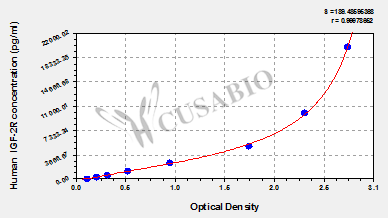Target Name
insulin-like growth factor 2 receptor
Alternative Names
300 kDa mannose 6 phosphate receptor ELISA Kit; 300 kDa mannose 6-phosphate receptor ELISA Kit; Cation independent mannose 6 phosphate receptor ELISA Kit; Cation-independent mannose-6-phosphate receptor ELISA Kit; CD222 ELISA Kit; CD222 antigen ELISA Kit; CI Man 6 P receptor ELISA Kit; CI Man-6-P receptor ELISA Kit; CI MPR ELISA Kit; CI-M6PR ELISA Kit; CI-MPR ELISA Kit; CIMPR ELISA Kit; IGF 2 receptor ELISA Kit; IGF 2R ELISA Kit; IGF II receptor ELISA Kit; IGF-II receptor ELISA Kit; IGF2 receptor ELISA Kit; Igf2r ELISA Kit; Insulin like growth factor 2 receptor ELISA Kit; Insulin like growth factor II receptor ELISA Kit; Insulin-like growth factor 2 receptor ELISA Kit; Insulin-like growth factor II receptor ELISA Kit; M6P R ELISA Kit; M6P/IGF2 receptor ELISA Kit; M6P/IGF2R ELISA Kit; M6PR ELISA Kit; mannose 6 phosphate receptor ELISA Kit; mannose 6 phosphate receptor, cation independent ELISA Kit; MPR 300 ELISA Kit; MPR300 ELISA Kit; MPRI ELISA Kit; MPRI_HUMAN ELISA Kit
Species
Homo sapiens (Human)
Sample Types
serum, plasma, tissue homogenates
Detection Range
312.5 pg/mL-20000 pg/mL
Detection Wavelength
450 nm
Research Area
Signal Transduction
Assay Principle
quantitative
Precision
| Intra-assay Precision (Precision within an assay): CV%<8% | | | |
| Three samples of known concentration were tested twenty times on one plate to assess. | |
| Inter-assay Precision (Precision between assays): CV%<10% | | | |
| Three samples of known concentration were tested in twenty assays to assess. | | |
| | | | | | | |
Linearity
| To assess the linearity of the assay, samples were spiked with high concentrations of human IGF-2R in various matrices and diluted with the Sample Diluent to produce samples with values within the dynamic range of the assay. |
| | Sample | Serum(n=4) | |
| 1:1 | Average % | 97 | |
| Range % | 92-103 | |
| 1:2 | Average % | 90 | |
| Range % | 83-96 | |
| 1:4 | Average % | 102 | |
| Range % | 99-105 | |
| 1:8 | Average % | 86 | |
| Range % | 81-92 | |
Recovery
| The recovery of human IGF-2R spiked to levels throughout the range of the assay in various matrices was evaluated. Samples were diluted prior to assay as directed in the Sample Preparation section. |
|
| Sample Type | Average % Recovery | Range | |
| Serum (n=5) | 92 | 87-98 | |
| EDTA plasma (n=4) | 89 | 82-95 | |
| | | | | | | |
| | | | | | | |
Typical Data
| These standard curves are provided for demonstration only. A standard curve should be generated for each set of samples assayed. |
|
 | pg/ml | OD1 | OD2 | Average | Corrected | | | 20000 | 2.821 | 2.752 | 2.787 | 2.666 | | | 10000 | 2.420 | 2.279 | 2.350 | 2.229 | | | 5000 | 1.764 | 1.789 | 1.777 | 1.656 | | | 2500 | 0.941 | 1.002 | 0.972 | 0.851 | | | 1250 | 0.527 | 0.555 | 0.541 | 0.420 | | | 625 | 0.318 | 0.346 | 0.332 | 0.211 | | | 312.5 | 0.214 | 0.225 | 0.220 | 0.099 | | | 0 | 0.126 | 0.116 | 0.121 | | |
|
Storage
Store at 2-8°C. Please refer to protocol.
Lead Time
3-5 working days after you place the order, and it takes another 3-5 days for delivery via DHL or FedEx.
